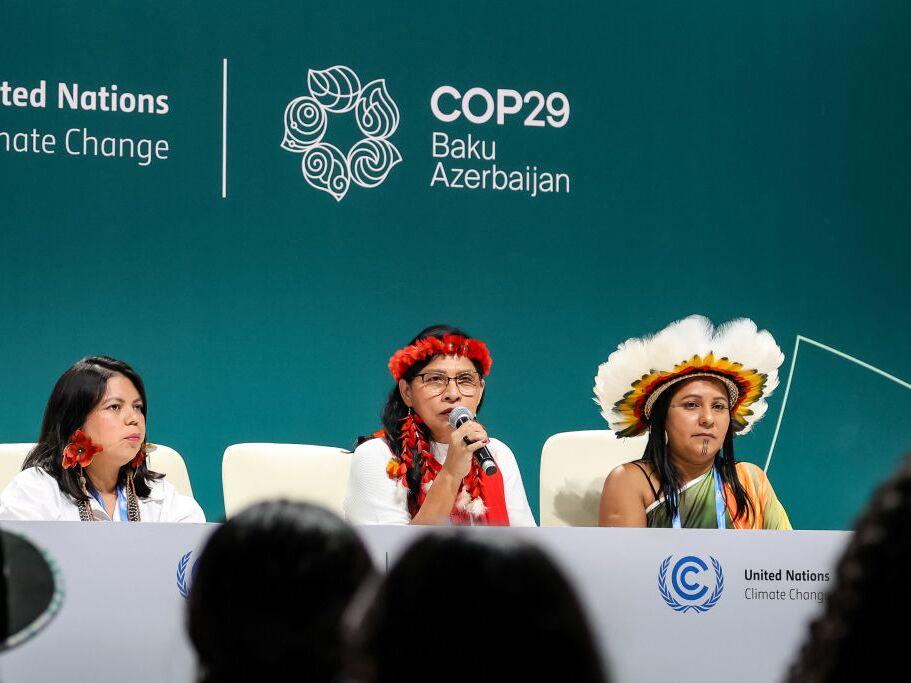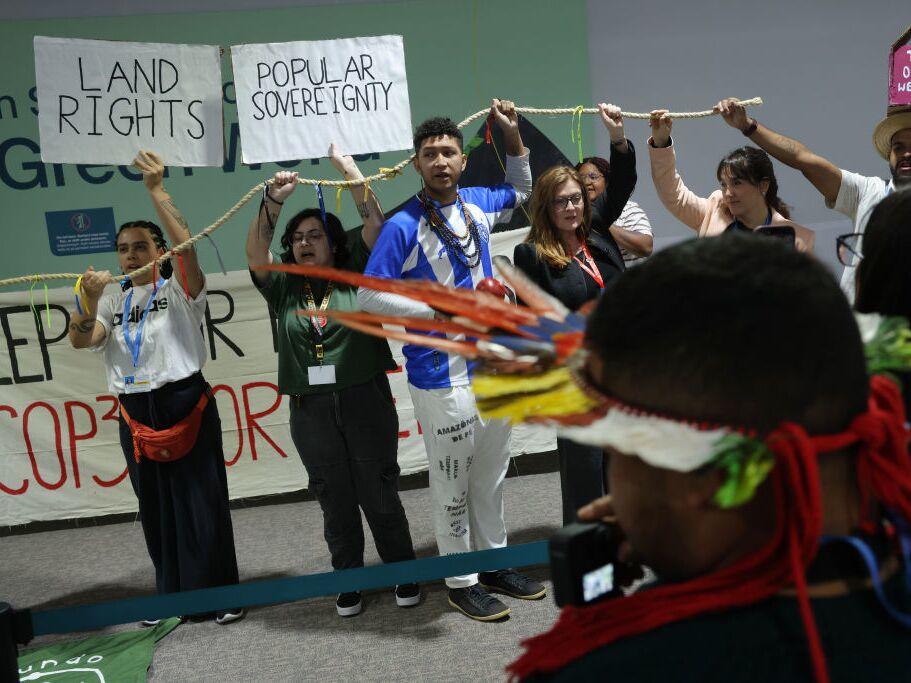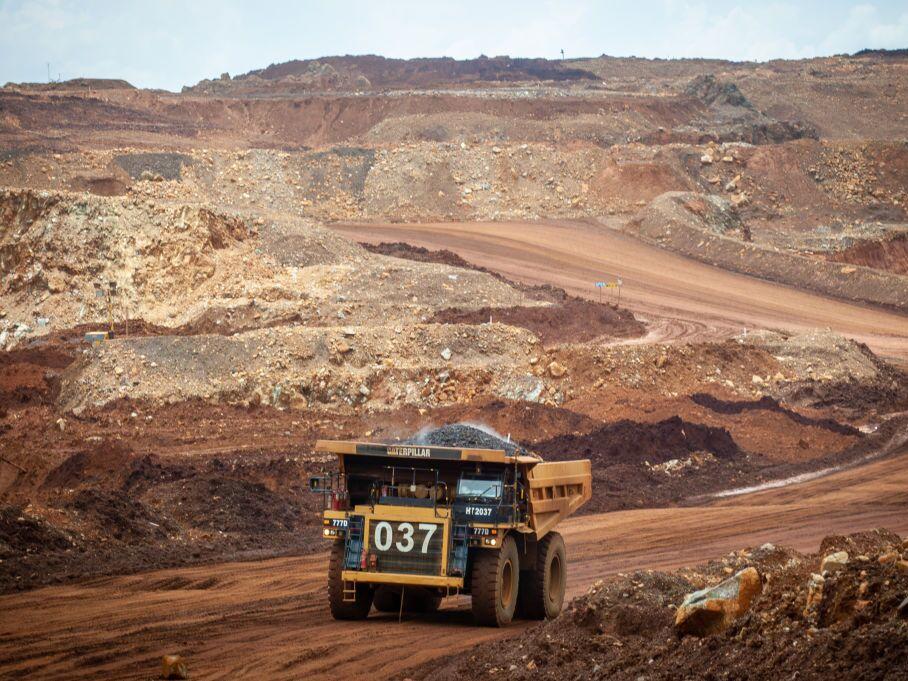Section Branding
Header Content
Disappointed by this year's climate talks, Indigenous advocates look to Brazil in 2025
Primary Content
Some Indigenous advocates at this year's international climate negotiations in Baku, Azerbaijan say the deals made fall short of what's needed to stave off the worst impacts of a warming planet, from sea level rise to catastrophic storms. COP29 ended with wealthy countries agreeing to help poorer nations with at least $300 billion annually to address global warming in a last-minute deal.
Advocates are now looking to next year's climate talks in Brazil, which some are calling the "Indigenous peoples" COP, to push for further inclusion in climate negotiations and support the global Indigenous movement.
This year, a group within COP known as the Local Communities and Indigenous Peoples Platform came to Baku with a set of priorities, which included advocating for a formal seat at the negotiating table for climate initiatives. They also wanted more Indigenous knowledge incorporated into climate science and policies. Leaders also called for protecting the human rights of Indigenous people and to safeguard tribal nations feeling the most adverse effects of climate change.
"Broadly speaking, the COP outcomes failed on all four of those [priorities]," explains Graeme Reed, who is Anishinaabe from the Great Lakes region. He was the North American representative to what's called the Facilitative Working Group, which carries out the platform's climate priorities by advising state party representatives that are willing to listen. These representatives can then bring ideas up in formal negotiations.
Reed called the final agreement out of COP29 "drastically insufficient."
Janene Yazzie, who is Diné (Navajo), also expressed disappointment. She joined Reed in the Facilitative Working Group as a North American representative. She says, despite the outcome, it's important for Indigenous people to build solidarity during the talks.
"It's very important for us to be here [in Baku] to advocate for our people to hold the line for effective and meaningful climate action and to continue to fight for the ability to access available climate finance that exists on the global scale," Yazzie says.
The climate finance deal nearly didn't happen after some developing nations walked out of negotiations over the weekend. Still, some have called the $300 billion a step in the right direction. Among them, President Biden, who said in a statement that the agreement was "ambitious" and that the money will help "mobilize the level of finance – from all sources – that developing countries need to accelerate the transition to clean, sustainable economies, while opening up new markets for American-made electric vehicles, batteries and other products."
Indigenous participation
Around 170 Indigenous people from around the world traveled to Baku. Groups representing Indigenous people across national borders do not have an official role when it comes to negotiating climate policy at COP. But they can advise countries willing to hear them out.
Eriel Tchekwie Deranger is a member of the Athabasca Chipewyan First Nation in Alberta, Canada and the executive director of the nonprofit Indigenous Climate Action.
"[We have] to really hope that sort of sympathetic states will listen to our desires and needs," Deranger says. "It's been really difficult, to be honest."
Indigenous organizations have become a growing part of COPs. But Deranger says participation was down this year. She points to Azerbaijan being so far away for many groups, expensive flights and concerns about the country's human rights record.
A recent analysis revealed that at least 1,773 fossil fuel lobbyists registered to attend COP29. Deranger said that far outnumbered Indigenous representation in Baku.
A just transition
Many Indigenous leaders at COP29 acknowledged the need for the renewable energy transition. However, many worry about mining for critical minerals that's needed for technologies that reduce climate pollution, like batteries, solar panels and electric vehicles. Mines are often on or near tribal lands. In the U.S., an analysis found more than 75% of lithium, copper and nickel reserves in the U.S. are located within 35 miles of Indigenous communities. Another study found that globally, 54% of all the minerals needed for the green energy transition are located on or near Indigenous lands.
Reed worries that the current demand for critical minerals legitimizes what he calls "sacrifice zones"— critical mineral sites near Indigenous and poor communities that can bring an increased risk of sexual violence for Native women, contaminate waterways and create more air pollution.
"We have all these technocrats who come to these gatherings, and they advance these solutions without really actually thinking about what is the future they're creating," Reed says. "For me, that future that they're creating is increasing inequity."
Not all tribal nations oppose mineral extraction on their territories. "Some want the mining, some don't want the mining," says David Kaimowitz, who's the chief program officer at the Tenure Facility, an organization that supports Indigenous people's land rights and forest management.
"I would say they want the right to decide what's going to happen in their ancestral territories, where their forefathers and foremothers are buried, where they hope to raise their grandchildren and their grandchildren's grandchildren," Kamowitz says.
Under international law, Indigenous people have the right to free, prior, and informed consent, which allows tribal nations to decide what's going to happen on their territories, such as mining, solar and hydroelectric projects.
A Seat at the table
The 16th United Nations Convention on Biological Diversity in Colombia this fall formerly recognized Indigenous people for their expertise. Reed says that's a step in the right direction.
But getting "tangible decision-making participation" at the formal negotiations at COP, he says, is still a long shot given that negotiations happen between governments, nations and states.
Indigenous people, Kaimowitz says, have had some success raising awareness and significant funds outside the formal UN climate talks, such as a $1.7 billion commitment to protect Indigenous peoples rights and forests. This agreement came together during COP26 in Scotland in 2021 and was established by five governments and 25 public and philanthropic donors. According to the Forest Tenure Funders Group, nearly $1.3 billion has been distributed already.
A recent report by the group, found a majority of that money – over a billion dollars – has gone to consulting firms, governments and NGO's. Reed says the funds that actually go to Indigenous people are minuscule compared to what government and conservation organizations receive.
"While those things are good, and I appreciate the advocacy that Indigenous peoples have brought," explains Reed, "the underlying system is still deeply colonial and is still unwilling to share power."
Direct access to funds
The U.S. election also loomed over this year's COP. Indigenous advocates are concerned over whether President-elect Donald Trump will withdraw the U.S. again from the Paris Agreement, something he did during his first term. Trump has said he will likely withdraw the country again from an agreement that set a global goal to limit warming to certain levels.
Yazzie also worries Trump's second term will lead to fewer federal dollars for tribes in the U.S.— money that could address the effects of climate change such as sea level rise.
That's a concern Fawn Sharp shares. She's a Quinault Indian Nation tribal member and a board member of the Nature Conservancy Global. Her tribe is feeling the effects of sea-level rise in Washington state and needs funds to relocate to higher ground.
The tribe received $25 million to relocate some villages through the Biden administration. But Sharp says Quinault Nation needs $500 million more to move all the villages.
"We knew it was quite clear we're not going to see that coming out of the United States Congress any time soon," Sharp says. That's why, she says, they're looking internationally for partnerships "to move to higher ground, to restore our salmon habitat and build our ecosystems."
Looking to next year's COP
Brazil hosts next year's United Nations climate summit and already some are calling it the "Indigenous Peoples" COP.
That's because Brazil is where 305 ethnic groups and 1.7 million Indigenous people call home. Indigenous people are also included in government representation including establishing the Brazilian Ministry of Indigenous Peoples in 2023.
COP30 will mark the first time the climate summit will be held in the Amazon basin — home to the world's largest tropical rainforest which naturally stores planet-warming pollution. The Amazon continues to face significant challenges, including deforestation and human-caused climate change, which has brought increased temperatures and drought.
Deranger and Yazzie say they are already preparing for Brazil, where they plan to continue advocating for Indigenous rights and representation.
"Brazil's gonna definitely be the largest Indigenous participation in COP history," Yazzie says.



